




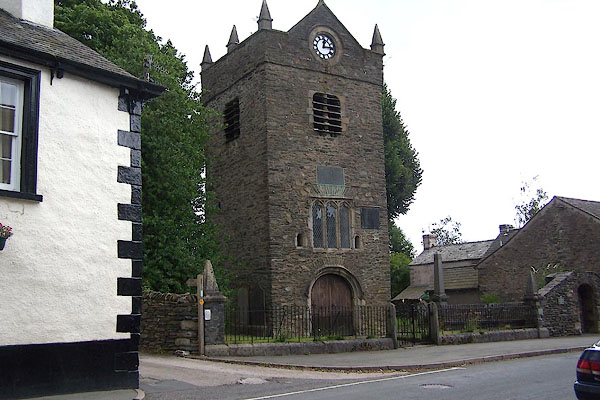
BJR12.jpg (taken 3.8.2005)
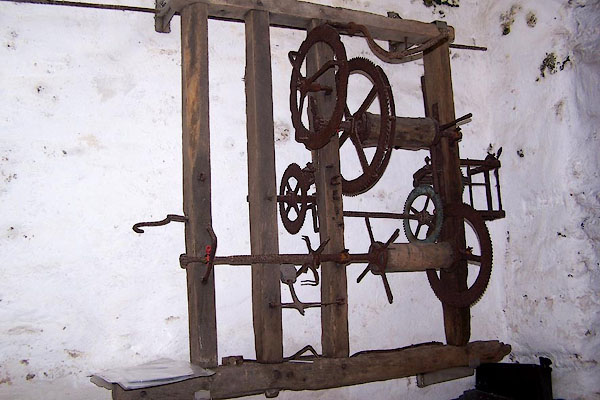
BOA53.jpg The turret clock, made 1744.
(taken 29.8.2007)
"Church (Per Curacy) / Grave Yard"
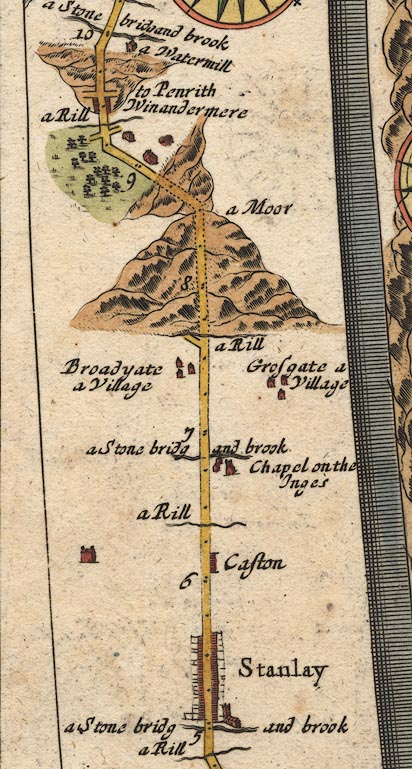
OG96m005.jpg
In mile 5, Westmoreland.
Church on the right of the road at:- "Stanlay"
item:- JandMN : 22
Image © see bottom of page

J5SD49NE.jpg
church
item:- National Library of Scotland : EME.s.47
Image © National Library of Scotland
item:- land tenure; border service
 goto source
goto sourcePage 121:- "... James the I. being very much distressed for money, and not knowing in what manner to raise it, had, along with some of his ministers, recourse to several schemes, (the following amongst the rest,) to extort it from his subjects. To spare trouble, I shall give the proclamation at large."
"BY THE KING,"
"A PROCLAMATION AGAINST TENANT-RIGHTS."
"WHEREAS it hath been oftentimes, by decrees and judgments at law, declared and settled, that tenant-rights, since the most happy union of these two renowned kingdoms of England and Scotland, in our person are utterly, by the ancient and fundamental rule of law of this our own kingdom of England, extinguished and abolished, being but dependencies of former separation and hostility; and that there is like settled rule and constant practice in Scotland since the union; and yet, nevertheless, divers suits are continually raised and prosecuted in our courts of justice here in England, grounded upon the said claim of tenant-right, or customary estate of inheritance, under that pretence; whereby, not only the memory of the said tenant-right is continued, which ought to be damned to a perpetual oblivion, but also both parties do sustain needless charge and impoverishment, in questioning that which is beyond all dispute, which may also open a way to turbulent and seditious attempts."
"We, out of our princely and never-intermitted care to avoid these maintainings aforesaid, have both given in change the matter to all our judges, to suppress and surcease strifes and suits of this nature, and have also given the express charge and commandment to all the principal officers and ministers of ourselves and our dearest son the Prince, (near or bordering upon Scotland where such tenant-rights have been claimed,) that they do let all estates, whether for lives or years, be it for fine or improvement of rent, by indenture only, and not otherwise, to the end to cease and discontinue the said claim. And further, to the end the same course may be uniform and general among all our"
"The barony of Kendal, which containeth near one half of the county of Westmorland, was given by William the Conqueror to Ivo de Tailebois, brother to the Earl of Anjou. This Ivo was a greater plunderer, according to Hume, than the Conqueror himself; for he robbed monasteries, churches, &c. William de Tailebois, the fifth baron of Kendale, obtained a licence from Henry the II. to take the surname of Lancaster. It continued not long in that name, but several acts of Parliament passed to the owners to take the name of Lancaster: At last it was divided between two sisters, viz. Helwisa, married to Peter de Brus, and Alicia, married to William de Lindesay, daughters of William de Lancastre the ninth baron of Kendale. The part of Helwisa was afterwards called the Richmond fee, from, as I suppose, the grant of it by Henry VI. to Margaret Countess Dowager of Richmond: The other part was called the Marquis fee, after the creation of the owner Sir William Parr, (brother to Catherine, the sixth wife of Henry the VIII.) and daughter of Sir Thomas Parr of Kendale, to be Marquis of Northampton by Henry the VIII."
 goto source
goto sourcePage 122:- "loving subjects, we do, by these presents, wish and expect, from all our loving subjects in those parts, that they shall follow and conform themselves to the same example for leasing such lands in manner aforesaid. But herewithall, we do strictly command, that no entry in any court-roll hereafter, either of our own honours or manors, or of the Prince's, or any of our subjects, do mention any estate termed of tenant-right or customary estate pretended of border-service. On the other side, our express pleasure is, that good and dutiful tenants, who shall willingly submit themselves to such estates, be used with all favour and moderation, as we doubt not but the landlord will do: Yet if any shall be found to do the contrary, our courts of enquity shall ever be open and ready to overrule such landlords: As, on the other side, both our courts of law and equity shall be, to bridle and eject all such unreasonable tenants as shall withstand it."
"Given at our Court at Charlton, the 28th day of July, in the eighteenth year of our reign of Great Britain, France, and Ireland, 1620."
"GOD SAVE THE KING."
"The Lords who had estates in the north readily coincided: upon which the tenants drew up a remonstrance, of which they made several copies, and a subscription and purse for the defence of their ancient customs, against the King, Prince, and Lords."
"Their border service they had quitted, but not their border spirit of liberty, and said "If the devil was lord, they would be tenants." The Prince of Wales began first, and exhibited a bill in chancery, complaining that the tenants claimed an estate on inheritance, &c. Whereupon the tenants met and subscribed the following articles, which, to shew our northern spirit, I shall put down."
""We, and every of us whose names are hereunto subscribed, having taken into consideration the danger of the times, do therefore, for ourselves, our heirs, executors, and administrators, severally agree, covenant, assume and promise unto and with each other, to observe and perform in every respect, part, and behalf, all and every article, clause, matter, and thing hereafter expressed, according to the true meaning of the same, viz."
""First, That we and every one of us, as in conscience we are bound, will stand to the general protestation by us taken, to the utmost of our and every of our abilities in every point."
"Second, Also, that to the utmost of our power, we and every of us, at all times hereafter, will defend our own persons, families, and estates; and the persons, families, and estates of one another, as far as lawfully may be."
""Third, Also, if any person or persons shall plunder, or go about in violent manner, without due course of law, to take away the persons, families, or goods of any of us, it shall be reputed as done to us all; and that upon notice given thereof to us, and every or any of us, every man having notice and able to do service, shall and will, with all speed and expedition, repair to the persons or places so plundered, pillaged, or restrained of their liberty, and shall to our utmost power rescue such persons and goods."
""Fourth, Also, that if any of our goods or estates, real or personal, shall happen to be violently taken away, contrary to law as aforesaid, if satisfaction cannot be gotten out of them who took them, the loss thereof shall be equally born, and restored to them so plundered, by us all who have hereunto subscribed; who shall be equally rated ac-"
 goto source
goto sourcePage 123:- "[ac]cording to every man's ability, by such persons or committees in evert town, hamlet, or village, as shall be agreed upon by the more part of us or them who have subscribed these presents, according to their true meaning.""
"However, the tenants under the Prince finding him a powerful enemy, and that they had no less a person than the King himself to contend with, (who was often Judge, Jury, and Counsel,) came to an agreement with the Prince, that for the sum of L.2700 he should confirm their ancient customs; which was accordingly done, and commissioners appointed to settle the same. These estates afterwards were called Lands held under the curtesy of England, or Queen's Lands."
"This did not settle the other lords, who ejected their tenants, and obtained decrees both in Chancery and the Exchequer: that did not, however, daunt their spirit, and the lords durst not take possession, so that they hold them to this day as estates of inheritance. Yet the customs differ a little in every manor, and many expensive lawsuits have been carried on about customs, by which the tenants hold them; but these disputes are in general now finally settled."
item:- bell; church bell
 goto source
goto sourcePage 23:- "... [Stavely] ... The chapel has a handsome tower and three bells."
courtesy of English Heritage
"TOWER OF CHAPEL OF ST MARGARET / / MAIN STREET / OVER STAVELEY / SOUTH LAKELAND / CUMBRIA / II[star] / 76488 / SD4713698176"
courtesy of English Heritage
"Tower only (Church demolished 1865). Said to have been founded in 1388. Probably late C14 or early C15 with later alterations. Rubble with limestone dressings; C20 limestone pinacles and coping to parapet. West doorway has moulded jambs and round-arched head under hood-mould with defaced labels; square headed window above of 3 trefoiled lights with hood mould and labels with small round headed niche to either side; bell opening with stone surround and slate louvres; gable with clock in memory of Queen Victoria's Golden Jubilee and plaque dated 1887. Plaque commemorating the men of Staveley who served in the South African campaign (1900-1901). East wall has square headed window of 2 trefoiled lights inserted in blocked opening."
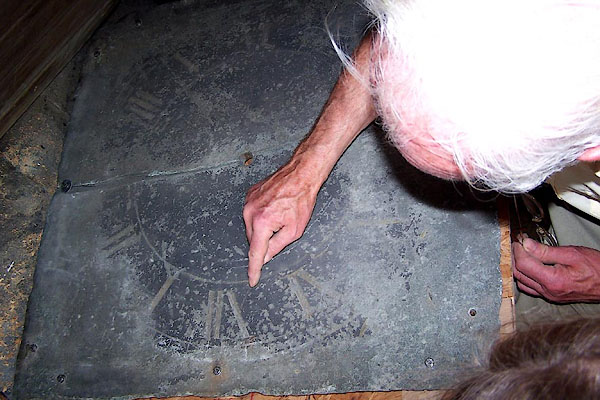
BOA54.jpg Dial for the turret clock, 1744; one hand, notice the hour divisions in fours.
(taken 29.8.2007)
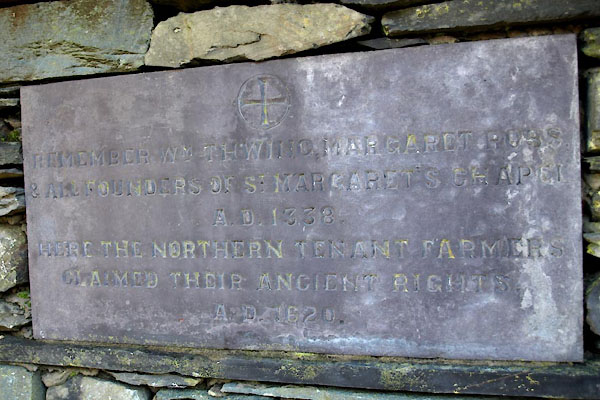
BTU64.jpg Plaque:-
"REMEMBER WM. THWINO, MARGARET [R]OSS. / &ALL FOUNDERS OF ST. MARGARET'S CHAPEL / A.D. 1338. / HERE THE NORTHERN TENANT FARMERS / CLAIMED THEIR ANCIENT RIGHTS. / A.D. 1620." (taken 19.11.2010)
